Analysis of the Business and Business Environment for Tesco
VerifiedAdded on 2021/02/18
|16
|4759
|27
Report
AI Summary
This report provides a comprehensive analysis of the business environment, focusing on Tesco as a case study. It begins by defining and differentiating between the public, private, and voluntary sectors, exploring their purposes, legal structures, and organizational sizes and scopes. The report then examines the interrelationships between various organizational functions, such as marketing, research and development, human resources, and finance, and how these functions contribute to achieving organizational objectives. Furthermore, the report delves into the impact of the macro environment on business operations, utilizing PESTLE analysis to identify both positive and negative influences. Finally, the report analyzes internal and external factors to identify the company's strengths and weaknesses and explains how these relate to the external macro factors, providing a holistic view of Tesco's business environment.
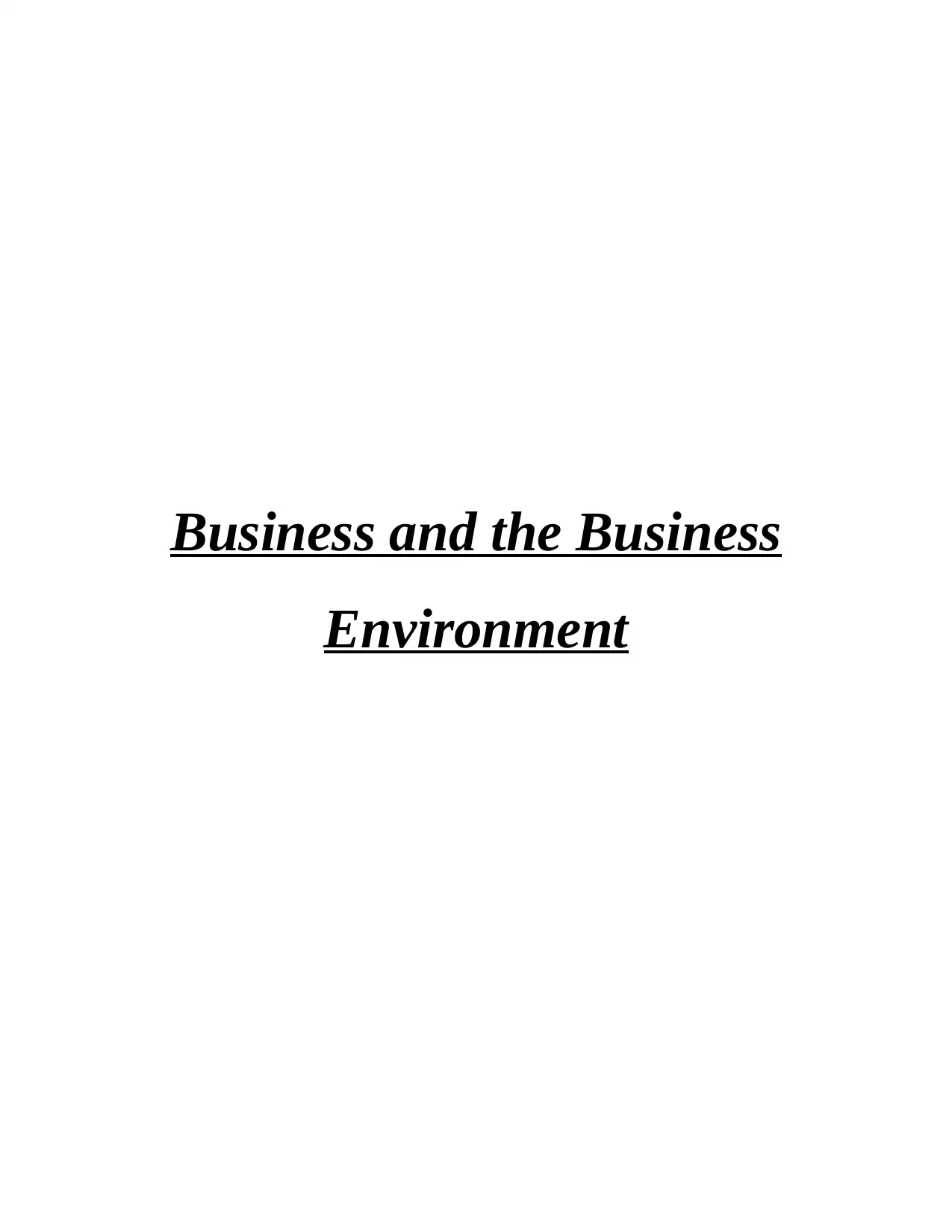
Business and the Business
Environment
Environment
Paraphrase This Document
Need a fresh take? Get an instant paraphrase of this document with our AI Paraphraser
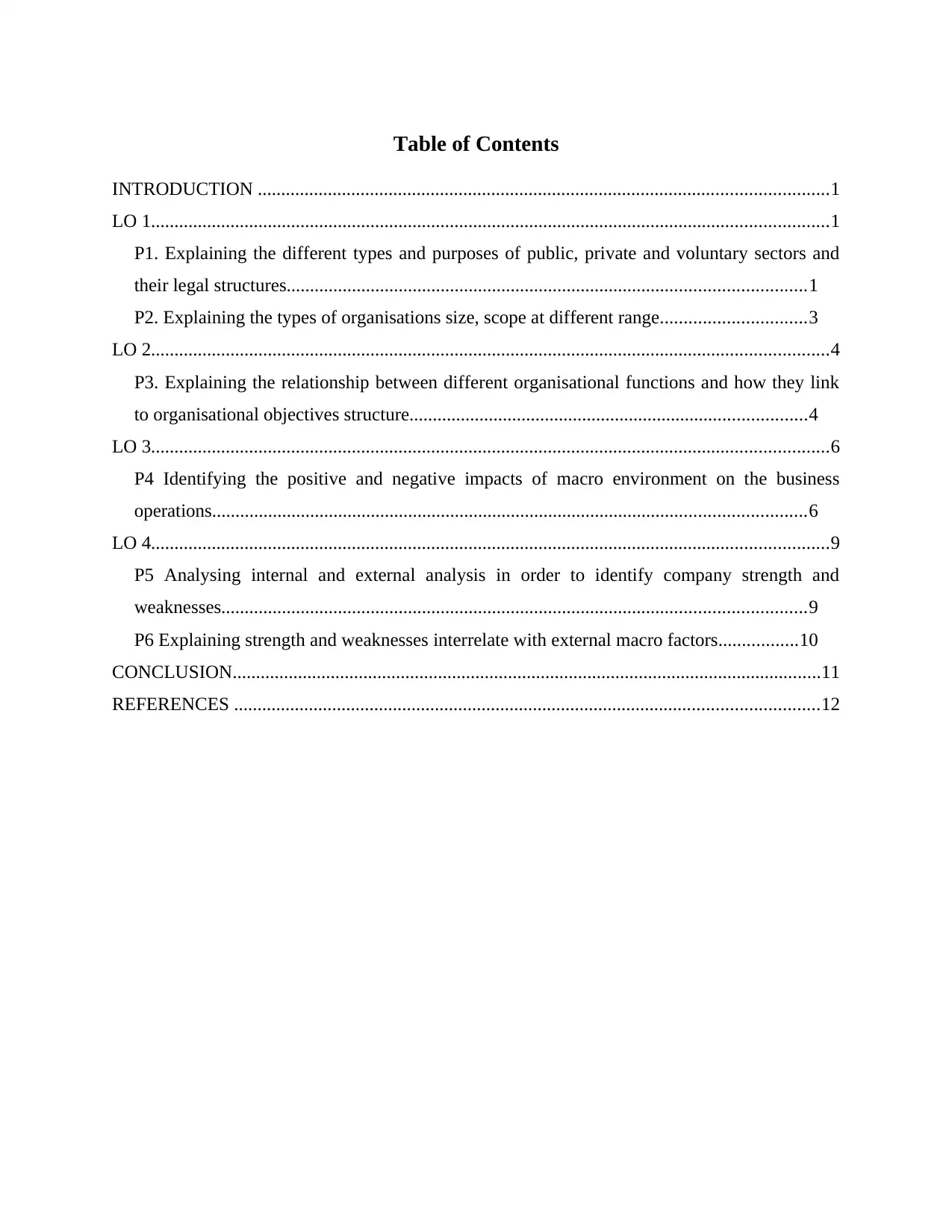
Table of Contents
INTRODUCTION ..........................................................................................................................1
LO 1.................................................................................................................................................1
P1. Explaining the different types and purposes of public, private and voluntary sectors and
their legal structures...............................................................................................................1
P2. Explaining the types of organisations size, scope at different range...............................3
LO 2.................................................................................................................................................4
P3. Explaining the relationship between different organisational functions and how they link
to organisational objectives structure.....................................................................................4
LO 3.................................................................................................................................................6
P4 Identifying the positive and negative impacts of macro environment on the business
operations...............................................................................................................................6
LO 4.................................................................................................................................................9
P5 Analysing internal and external analysis in order to identify company strength and
weaknesses.............................................................................................................................9
P6 Explaining strength and weaknesses interrelate with external macro factors.................10
CONCLUSION..............................................................................................................................11
REFERENCES .............................................................................................................................12
INTRODUCTION ..........................................................................................................................1
LO 1.................................................................................................................................................1
P1. Explaining the different types and purposes of public, private and voluntary sectors and
their legal structures...............................................................................................................1
P2. Explaining the types of organisations size, scope at different range...............................3
LO 2.................................................................................................................................................4
P3. Explaining the relationship between different organisational functions and how they link
to organisational objectives structure.....................................................................................4
LO 3.................................................................................................................................................6
P4 Identifying the positive and negative impacts of macro environment on the business
operations...............................................................................................................................6
LO 4.................................................................................................................................................9
P5 Analysing internal and external analysis in order to identify company strength and
weaknesses.............................................................................................................................9
P6 Explaining strength and weaknesses interrelate with external macro factors.................10
CONCLUSION..............................................................................................................................11
REFERENCES .............................................................................................................................12

⊘ This is a preview!⊘
Do you want full access?
Subscribe today to unlock all pages.

Trusted by 1+ million students worldwide
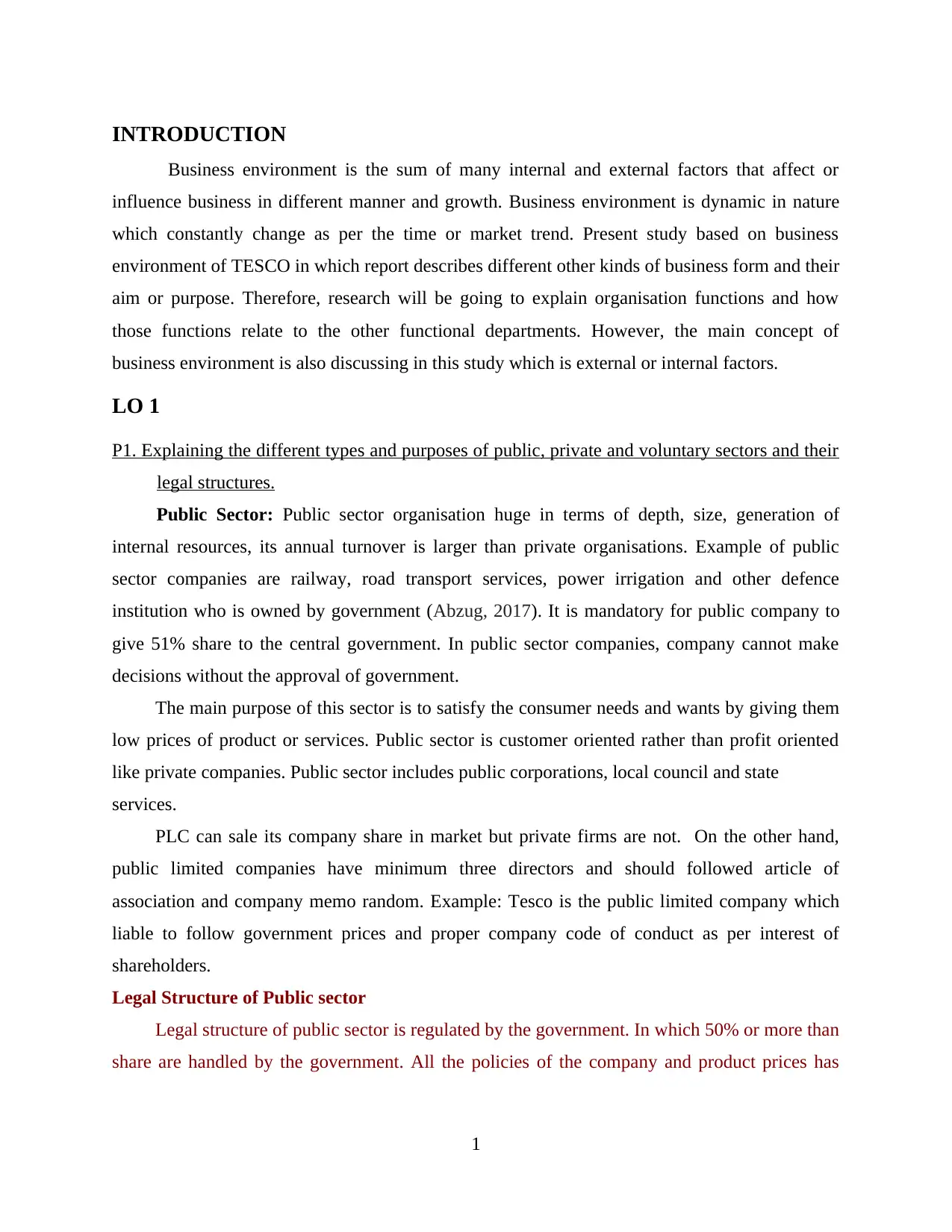
INTRODUCTION
Business environment is the sum of many internal and external factors that affect or
influence business in different manner and growth. Business environment is dynamic in nature
which constantly change as per the time or market trend. Present study based on business
environment of TESCO in which report describes different other kinds of business form and their
aim or purpose. Therefore, research will be going to explain organisation functions and how
those functions relate to the other functional departments. However, the main concept of
business environment is also discussing in this study which is external or internal factors.
LO 1
P1. Explaining the different types and purposes of public, private and voluntary sectors and their
legal structures.
Public Sector: Public sector organisation huge in terms of depth, size, generation of
internal resources, its annual turnover is larger than private organisations. Example of public
sector companies are railway, road transport services, power irrigation and other defence
institution who is owned by government (Abzug, 2017). It is mandatory for public company to
give 51% share to the central government. In public sector companies, company cannot make
decisions without the approval of government.
The main purpose of this sector is to satisfy the consumer needs and wants by giving them
low prices of product or services. Public sector is customer oriented rather than profit oriented
like private companies. Public sector includes public corporations, local council and state
services.
PLC can sale its company share in market but private firms are not. On the other hand,
public limited companies have minimum three directors and should followed article of
association and company memo random. Example: Tesco is the public limited company which
liable to follow government prices and proper company code of conduct as per interest of
shareholders.
Legal Structure of Public sector
Legal structure of public sector is regulated by the government. In which 50% or more than
share are handled by the government. All the policies of the company and product prices has
1
Business environment is the sum of many internal and external factors that affect or
influence business in different manner and growth. Business environment is dynamic in nature
which constantly change as per the time or market trend. Present study based on business
environment of TESCO in which report describes different other kinds of business form and their
aim or purpose. Therefore, research will be going to explain organisation functions and how
those functions relate to the other functional departments. However, the main concept of
business environment is also discussing in this study which is external or internal factors.
LO 1
P1. Explaining the different types and purposes of public, private and voluntary sectors and their
legal structures.
Public Sector: Public sector organisation huge in terms of depth, size, generation of
internal resources, its annual turnover is larger than private organisations. Example of public
sector companies are railway, road transport services, power irrigation and other defence
institution who is owned by government (Abzug, 2017). It is mandatory for public company to
give 51% share to the central government. In public sector companies, company cannot make
decisions without the approval of government.
The main purpose of this sector is to satisfy the consumer needs and wants by giving them
low prices of product or services. Public sector is customer oriented rather than profit oriented
like private companies. Public sector includes public corporations, local council and state
services.
PLC can sale its company share in market but private firms are not. On the other hand,
public limited companies have minimum three directors and should followed article of
association and company memo random. Example: Tesco is the public limited company which
liable to follow government prices and proper company code of conduct as per interest of
shareholders.
Legal Structure of Public sector
Legal structure of public sector is regulated by the government. In which 50% or more than
share are handled by the government. All the policies of the company and product prices has
1
Paraphrase This Document
Need a fresh take? Get an instant paraphrase of this document with our AI Paraphraser
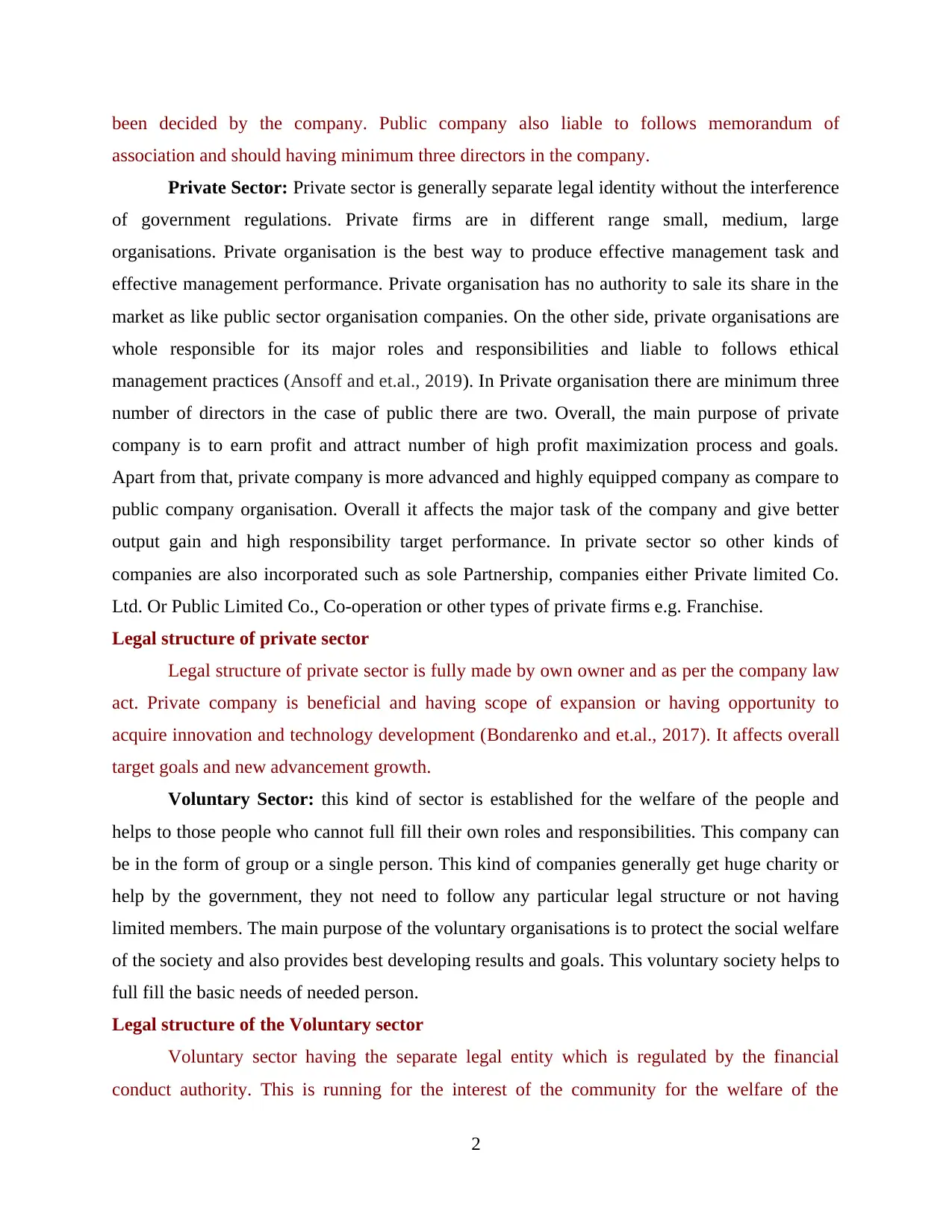
been decided by the company. Public company also liable to follows memorandum of
association and should having minimum three directors in the company.
Private Sector: Private sector is generally separate legal identity without the interference
of government regulations. Private firms are in different range small, medium, large
organisations. Private organisation is the best way to produce effective management task and
effective management performance. Private organisation has no authority to sale its share in the
market as like public sector organisation companies. On the other side, private organisations are
whole responsible for its major roles and responsibilities and liable to follows ethical
management practices (Ansoff and et.al., 2019). In Private organisation there are minimum three
number of directors in the case of public there are two. Overall, the main purpose of private
company is to earn profit and attract number of high profit maximization process and goals.
Apart from that, private company is more advanced and highly equipped company as compare to
public company organisation. Overall it affects the major task of the company and give better
output gain and high responsibility target performance. In private sector so other kinds of
companies are also incorporated such as sole Partnership, companies either Private limited Co.
Ltd. Or Public Limited Co., Co-operation or other types of private firms e.g. Franchise.
Legal structure of private sector
Legal structure of private sector is fully made by own owner and as per the company law
act. Private company is beneficial and having scope of expansion or having opportunity to
acquire innovation and technology development (Bondarenko and et.al., 2017). It affects overall
target goals and new advancement growth.
Voluntary Sector: this kind of sector is established for the welfare of the people and
helps to those people who cannot full fill their own roles and responsibilities. This company can
be in the form of group or a single person. This kind of companies generally get huge charity or
help by the government, they not need to follow any particular legal structure or not having
limited members. The main purpose of the voluntary organisations is to protect the social welfare
of the society and also provides best developing results and goals. This voluntary society helps to
full fill the basic needs of needed person.
Legal structure of the Voluntary sector
Voluntary sector having the separate legal entity which is regulated by the financial
conduct authority. This is running for the interest of the community for the welfare of the
2
association and should having minimum three directors in the company.
Private Sector: Private sector is generally separate legal identity without the interference
of government regulations. Private firms are in different range small, medium, large
organisations. Private organisation is the best way to produce effective management task and
effective management performance. Private organisation has no authority to sale its share in the
market as like public sector organisation companies. On the other side, private organisations are
whole responsible for its major roles and responsibilities and liable to follows ethical
management practices (Ansoff and et.al., 2019). In Private organisation there are minimum three
number of directors in the case of public there are two. Overall, the main purpose of private
company is to earn profit and attract number of high profit maximization process and goals.
Apart from that, private company is more advanced and highly equipped company as compare to
public company organisation. Overall it affects the major task of the company and give better
output gain and high responsibility target performance. In private sector so other kinds of
companies are also incorporated such as sole Partnership, companies either Private limited Co.
Ltd. Or Public Limited Co., Co-operation or other types of private firms e.g. Franchise.
Legal structure of private sector
Legal structure of private sector is fully made by own owner and as per the company law
act. Private company is beneficial and having scope of expansion or having opportunity to
acquire innovation and technology development (Bondarenko and et.al., 2017). It affects overall
target goals and new advancement growth.
Voluntary Sector: this kind of sector is established for the welfare of the people and
helps to those people who cannot full fill their own roles and responsibilities. This company can
be in the form of group or a single person. This kind of companies generally get huge charity or
help by the government, they not need to follow any particular legal structure or not having
limited members. The main purpose of the voluntary organisations is to protect the social welfare
of the society and also provides best developing results and goals. This voluntary society helps to
full fill the basic needs of needed person.
Legal structure of the Voluntary sector
Voluntary sector having the separate legal entity which is regulated by the financial
conduct authority. This is running for the interest of the community for the welfare of the
2
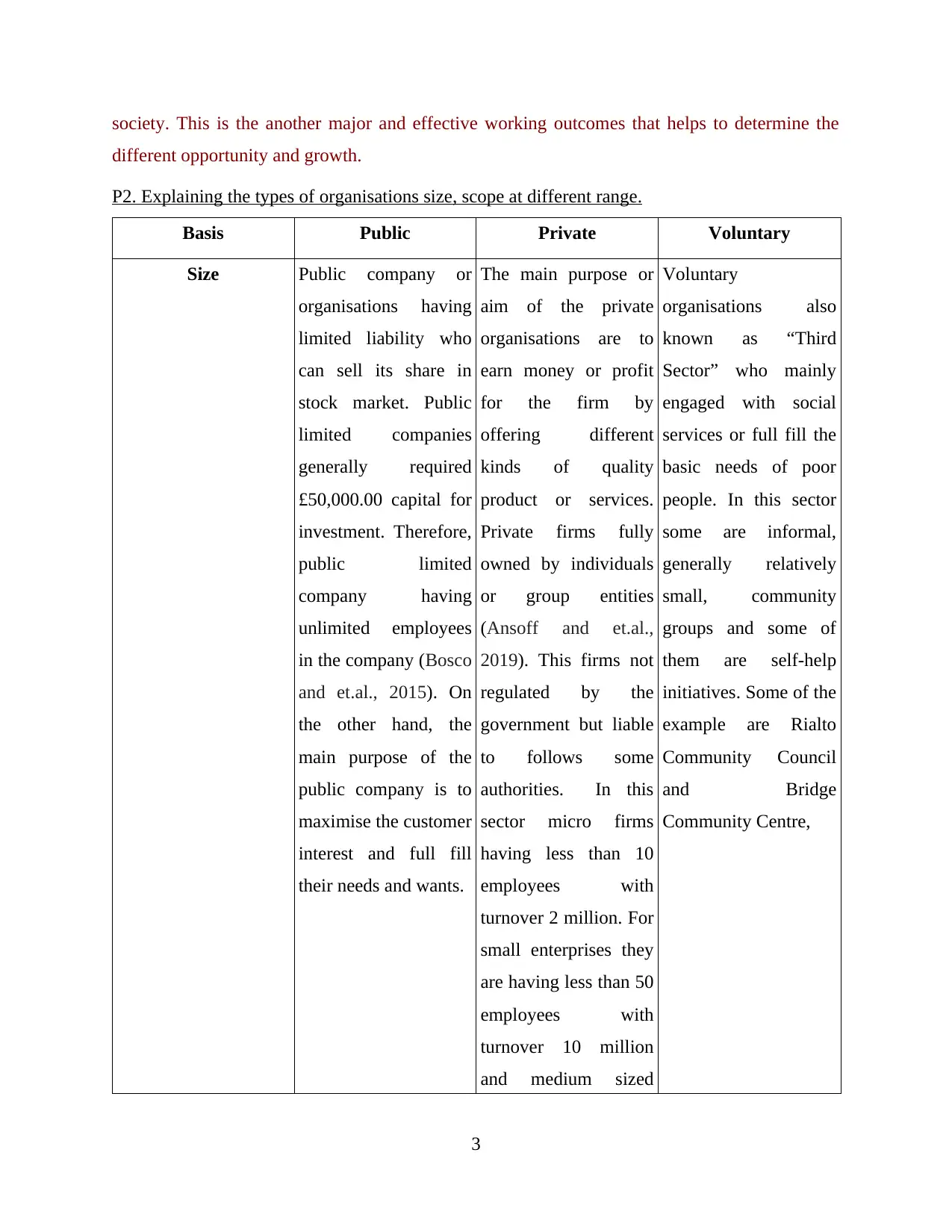
society. This is the another major and effective working outcomes that helps to determine the
different opportunity and growth.
P2. Explaining the types of organisations size, scope at different range.
Basis Public Private Voluntary
Size Public company or
organisations having
limited liability who
can sell its share in
stock market. Public
limited companies
generally required
£50,000.00 capital for
investment. Therefore,
public limited
company having
unlimited employees
in the company (Bosco
and et.al., 2015). On
the other hand, the
main purpose of the
public company is to
maximise the customer
interest and full fill
their needs and wants.
The main purpose or
aim of the private
organisations are to
earn money or profit
for the firm by
offering different
kinds of quality
product or services.
Private firms fully
owned by individuals
or group entities
(Ansoff and et.al.,
2019). This firms not
regulated by the
government but liable
to follows some
authorities. In this
sector micro firms
having less than 10
employees with
turnover 2 million. For
small enterprises they
are having less than 50
employees with
turnover 10 million
and medium sized
Voluntary
organisations also
known as “Third
Sector” who mainly
engaged with social
services or full fill the
basic needs of poor
people. In this sector
some are informal,
generally relatively
small, community
groups and some of
them are self-help
initiatives. Some of the
example are Rialto
Community Council
and Bridge
Community Centre,
3
different opportunity and growth.
P2. Explaining the types of organisations size, scope at different range.
Basis Public Private Voluntary
Size Public company or
organisations having
limited liability who
can sell its share in
stock market. Public
limited companies
generally required
£50,000.00 capital for
investment. Therefore,
public limited
company having
unlimited employees
in the company (Bosco
and et.al., 2015). On
the other hand, the
main purpose of the
public company is to
maximise the customer
interest and full fill
their needs and wants.
The main purpose or
aim of the private
organisations are to
earn money or profit
for the firm by
offering different
kinds of quality
product or services.
Private firms fully
owned by individuals
or group entities
(Ansoff and et.al.,
2019). This firms not
regulated by the
government but liable
to follows some
authorities. In this
sector micro firms
having less than 10
employees with
turnover 2 million. For
small enterprises they
are having less than 50
employees with
turnover 10 million
and medium sized
Voluntary
organisations also
known as “Third
Sector” who mainly
engaged with social
services or full fill the
basic needs of poor
people. In this sector
some are informal,
generally relatively
small, community
groups and some of
them are self-help
initiatives. Some of the
example are Rialto
Community Council
and Bridge
Community Centre,
3
⊘ This is a preview!⊘
Do you want full access?
Subscribe today to unlock all pages.

Trusted by 1+ million students worldwide
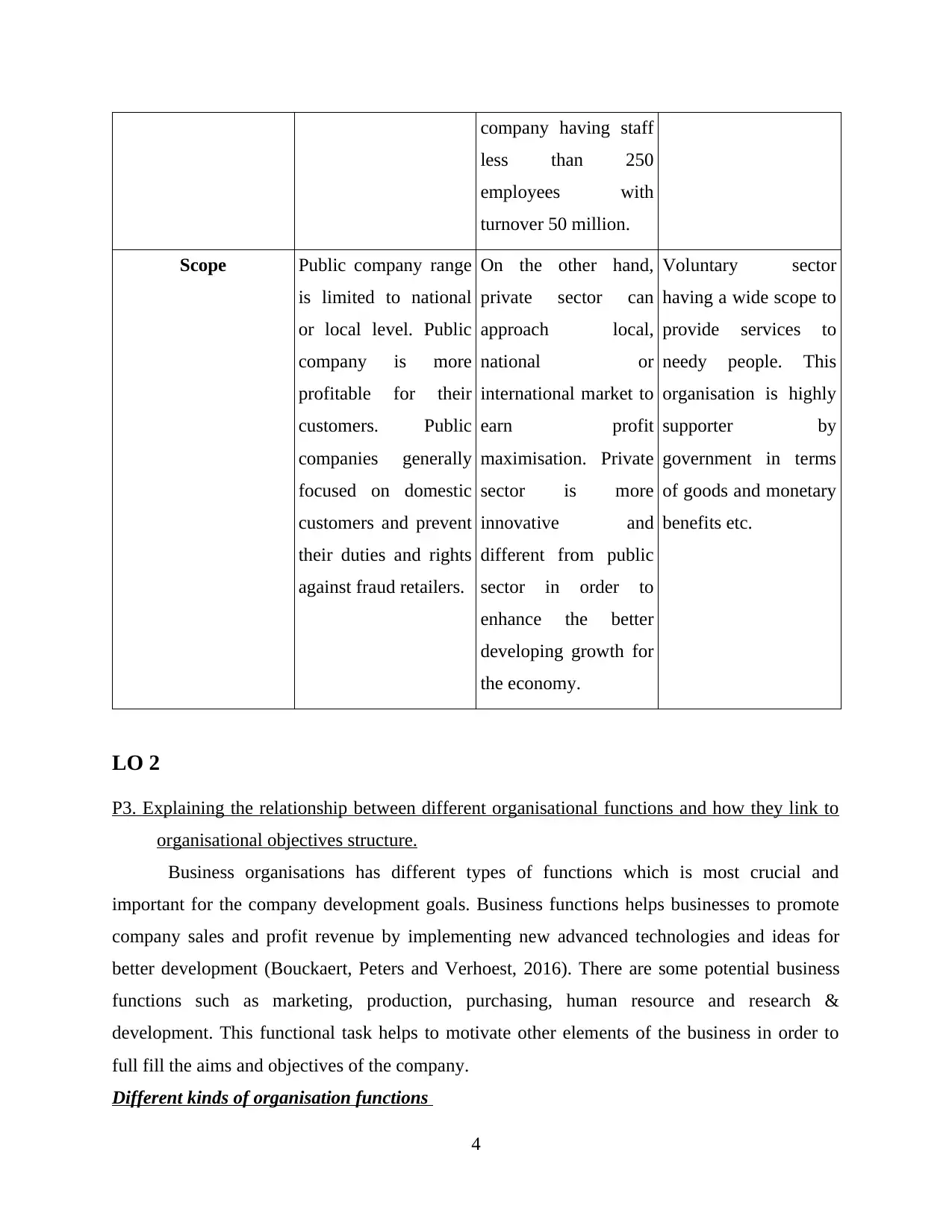
company having staff
less than 250
employees with
turnover 50 million.
Scope Public company range
is limited to national
or local level. Public
company is more
profitable for their
customers. Public
companies generally
focused on domestic
customers and prevent
their duties and rights
against fraud retailers.
On the other hand,
private sector can
approach local,
national or
international market to
earn profit
maximisation. Private
sector is more
innovative and
different from public
sector in order to
enhance the better
developing growth for
the economy.
Voluntary sector
having a wide scope to
provide services to
needy people. This
organisation is highly
supporter by
government in terms
of goods and monetary
benefits etc.
LO 2
P3. Explaining the relationship between different organisational functions and how they link to
organisational objectives structure.
Business organisations has different types of functions which is most crucial and
important for the company development goals. Business functions helps businesses to promote
company sales and profit revenue by implementing new advanced technologies and ideas for
better development (Bouckaert, Peters and Verhoest, 2016). There are some potential business
functions such as marketing, production, purchasing, human resource and research &
development. This functional task helps to motivate other elements of the business in order to
full fill the aims and objectives of the company.
Different kinds of organisation functions
4
less than 250
employees with
turnover 50 million.
Scope Public company range
is limited to national
or local level. Public
company is more
profitable for their
customers. Public
companies generally
focused on domestic
customers and prevent
their duties and rights
against fraud retailers.
On the other hand,
private sector can
approach local,
national or
international market to
earn profit
maximisation. Private
sector is more
innovative and
different from public
sector in order to
enhance the better
developing growth for
the economy.
Voluntary sector
having a wide scope to
provide services to
needy people. This
organisation is highly
supporter by
government in terms
of goods and monetary
benefits etc.
LO 2
P3. Explaining the relationship between different organisational functions and how they link to
organisational objectives structure.
Business organisations has different types of functions which is most crucial and
important for the company development goals. Business functions helps businesses to promote
company sales and profit revenue by implementing new advanced technologies and ideas for
better development (Bouckaert, Peters and Verhoest, 2016). There are some potential business
functions such as marketing, production, purchasing, human resource and research &
development. This functional task helps to motivate other elements of the business in order to
full fill the aims and objectives of the company.
Different kinds of organisation functions
4
Paraphrase This Document
Need a fresh take? Get an instant paraphrase of this document with our AI Paraphraser
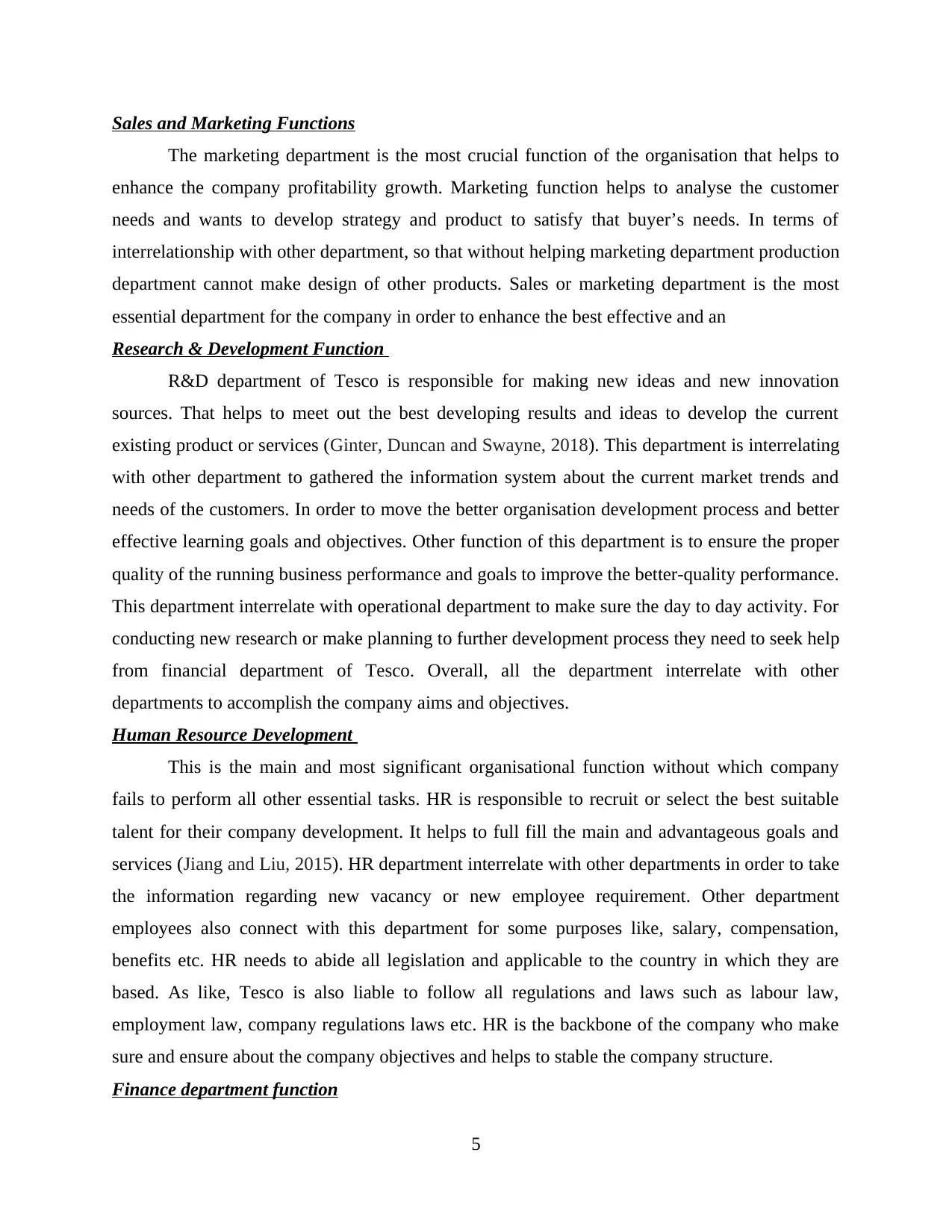
Sales and Marketing Functions
The marketing department is the most crucial function of the organisation that helps to
enhance the company profitability growth. Marketing function helps to analyse the customer
needs and wants to develop strategy and product to satisfy that buyer’s needs. In terms of
interrelationship with other department, so that without helping marketing department production
department cannot make design of other products. Sales or marketing department is the most
essential department for the company in order to enhance the best effective and an
Research & Development Function
R&D department of Tesco is responsible for making new ideas and new innovation
sources. That helps to meet out the best developing results and ideas to develop the current
existing product or services (Ginter, Duncan and Swayne, 2018). This department is interrelating
with other department to gathered the information system about the current market trends and
needs of the customers. In order to move the better organisation development process and better
effective learning goals and objectives. Other function of this department is to ensure the proper
quality of the running business performance and goals to improve the better-quality performance.
This department interrelate with operational department to make sure the day to day activity. For
conducting new research or make planning to further development process they need to seek help
from financial department of Tesco. Overall, all the department interrelate with other
departments to accomplish the company aims and objectives.
Human Resource Development
This is the main and most significant organisational function without which company
fails to perform all other essential tasks. HR is responsible to recruit or select the best suitable
talent for their company development. It helps to full fill the main and advantageous goals and
services (Jiang and Liu, 2015). HR department interrelate with other departments in order to take
the information regarding new vacancy or new employee requirement. Other department
employees also connect with this department for some purposes like, salary, compensation,
benefits etc. HR needs to abide all legislation and applicable to the country in which they are
based. As like, Tesco is also liable to follow all regulations and laws such as labour law,
employment law, company regulations laws etc. HR is the backbone of the company who make
sure and ensure about the company objectives and helps to stable the company structure.
Finance department function
5
The marketing department is the most crucial function of the organisation that helps to
enhance the company profitability growth. Marketing function helps to analyse the customer
needs and wants to develop strategy and product to satisfy that buyer’s needs. In terms of
interrelationship with other department, so that without helping marketing department production
department cannot make design of other products. Sales or marketing department is the most
essential department for the company in order to enhance the best effective and an
Research & Development Function
R&D department of Tesco is responsible for making new ideas and new innovation
sources. That helps to meet out the best developing results and ideas to develop the current
existing product or services (Ginter, Duncan and Swayne, 2018). This department is interrelating
with other department to gathered the information system about the current market trends and
needs of the customers. In order to move the better organisation development process and better
effective learning goals and objectives. Other function of this department is to ensure the proper
quality of the running business performance and goals to improve the better-quality performance.
This department interrelate with operational department to make sure the day to day activity. For
conducting new research or make planning to further development process they need to seek help
from financial department of Tesco. Overall, all the department interrelate with other
departments to accomplish the company aims and objectives.
Human Resource Development
This is the main and most significant organisational function without which company
fails to perform all other essential tasks. HR is responsible to recruit or select the best suitable
talent for their company development. It helps to full fill the main and advantageous goals and
services (Jiang and Liu, 2015). HR department interrelate with other departments in order to take
the information regarding new vacancy or new employee requirement. Other department
employees also connect with this department for some purposes like, salary, compensation,
benefits etc. HR needs to abide all legislation and applicable to the country in which they are
based. As like, Tesco is also liable to follow all regulations and laws such as labour law,
employment law, company regulations laws etc. HR is the backbone of the company who make
sure and ensure about the company objectives and helps to stable the company structure.
Finance department function
5
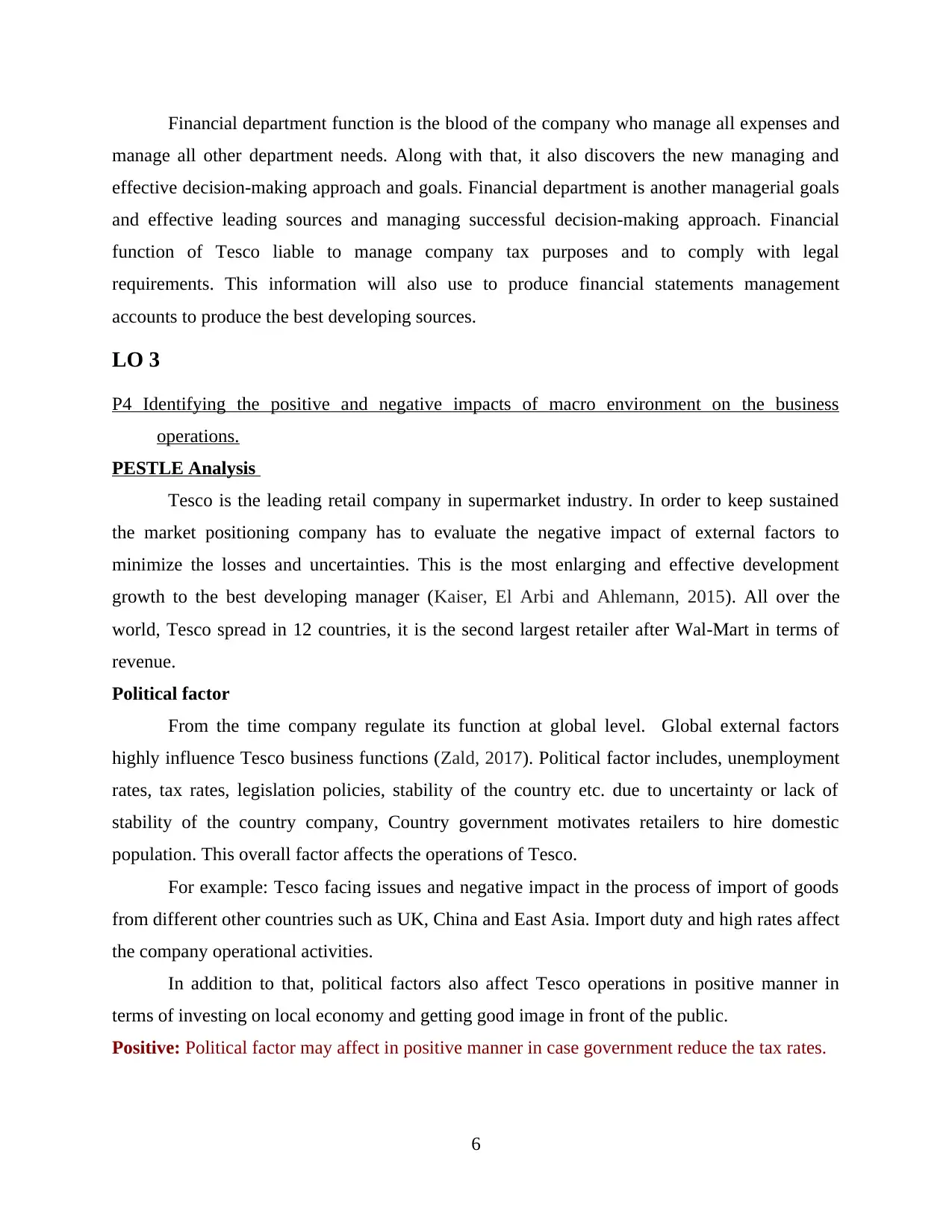
Financial department function is the blood of the company who manage all expenses and
manage all other department needs. Along with that, it also discovers the new managing and
effective decision-making approach and goals. Financial department is another managerial goals
and effective leading sources and managing successful decision-making approach. Financial
function of Tesco liable to manage company tax purposes and to comply with legal
requirements. This information will also use to produce financial statements management
accounts to produce the best developing sources.
LO 3
P4 Identifying the positive and negative impacts of macro environment on the business
operations.
PESTLE Analysis
Tesco is the leading retail company in supermarket industry. In order to keep sustained
the market positioning company has to evaluate the negative impact of external factors to
minimize the losses and uncertainties. This is the most enlarging and effective development
growth to the best developing manager (Kaiser, El Arbi and Ahlemann, 2015). All over the
world, Tesco spread in 12 countries, it is the second largest retailer after Wal-Mart in terms of
revenue.
Political factor
From the time company regulate its function at global level. Global external factors
highly influence Tesco business functions (Zald, 2017). Political factor includes, unemployment
rates, tax rates, legislation policies, stability of the country etc. due to uncertainty or lack of
stability of the country company, Country government motivates retailers to hire domestic
population. This overall factor affects the operations of Tesco.
For example: Tesco facing issues and negative impact in the process of import of goods
from different other countries such as UK, China and East Asia. Import duty and high rates affect
the company operational activities.
In addition to that, political factors also affect Tesco operations in positive manner in
terms of investing on local economy and getting good image in front of the public.
Positive: Political factor may affect in positive manner in case government reduce the tax rates.
6
manage all other department needs. Along with that, it also discovers the new managing and
effective decision-making approach and goals. Financial department is another managerial goals
and effective leading sources and managing successful decision-making approach. Financial
function of Tesco liable to manage company tax purposes and to comply with legal
requirements. This information will also use to produce financial statements management
accounts to produce the best developing sources.
LO 3
P4 Identifying the positive and negative impacts of macro environment on the business
operations.
PESTLE Analysis
Tesco is the leading retail company in supermarket industry. In order to keep sustained
the market positioning company has to evaluate the negative impact of external factors to
minimize the losses and uncertainties. This is the most enlarging and effective development
growth to the best developing manager (Kaiser, El Arbi and Ahlemann, 2015). All over the
world, Tesco spread in 12 countries, it is the second largest retailer after Wal-Mart in terms of
revenue.
Political factor
From the time company regulate its function at global level. Global external factors
highly influence Tesco business functions (Zald, 2017). Political factor includes, unemployment
rates, tax rates, legislation policies, stability of the country etc. due to uncertainty or lack of
stability of the country company, Country government motivates retailers to hire domestic
population. This overall factor affects the operations of Tesco.
For example: Tesco facing issues and negative impact in the process of import of goods
from different other countries such as UK, China and East Asia. Import duty and high rates affect
the company operational activities.
In addition to that, political factors also affect Tesco operations in positive manner in
terms of investing on local economy and getting good image in front of the public.
Positive: Political factor may affect in positive manner in case government reduce the tax rates.
6
⊘ This is a preview!⊘
Do you want full access?
Subscribe today to unlock all pages.

Trusted by 1+ million students worldwide
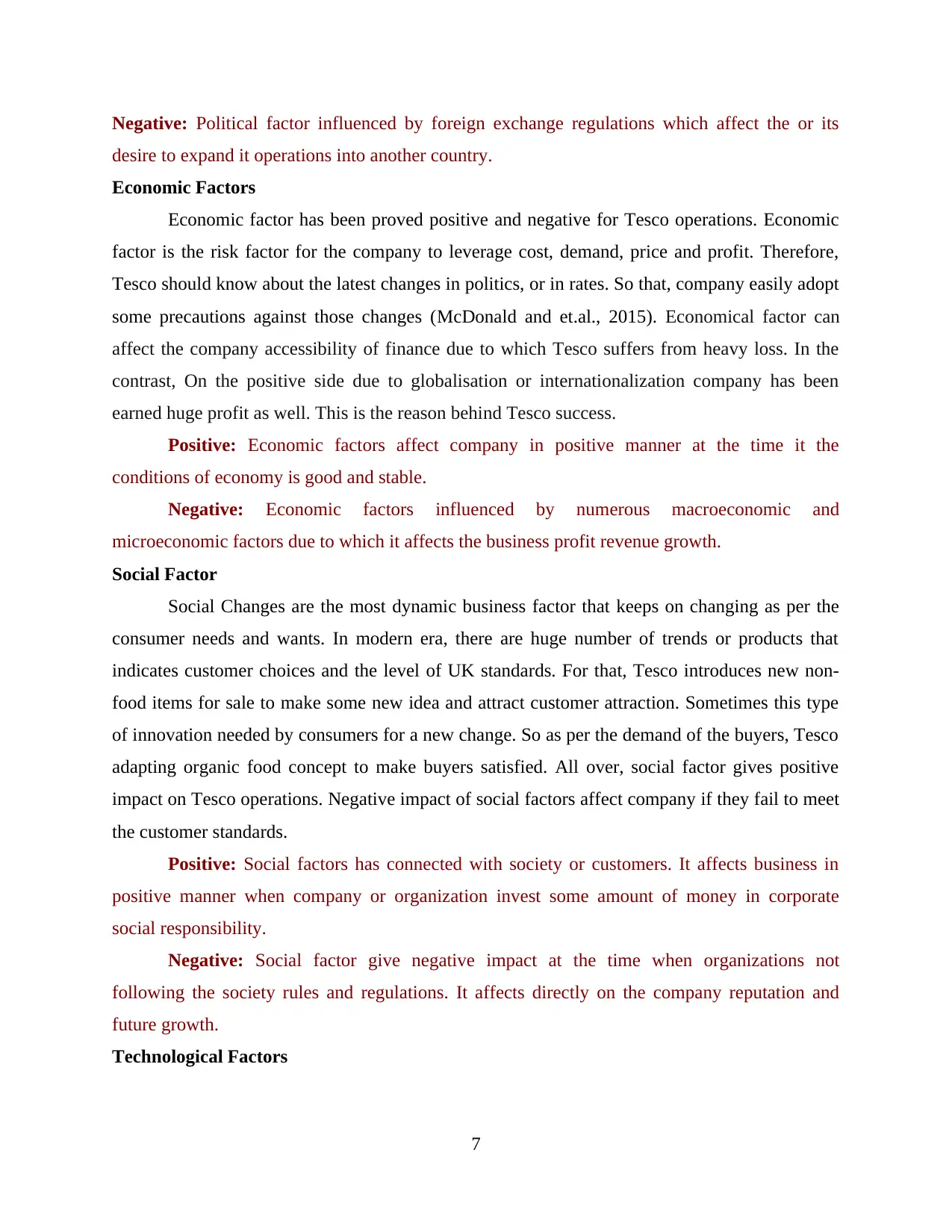
Negative: Political factor influenced by foreign exchange regulations which affect the or its
desire to expand it operations into another country.
Economic Factors
Economic factor has been proved positive and negative for Tesco operations. Economic
factor is the risk factor for the company to leverage cost, demand, price and profit. Therefore,
Tesco should know about the latest changes in politics, or in rates. So that, company easily adopt
some precautions against those changes (McDonald and et.al., 2015). Economical factor can
affect the company accessibility of finance due to which Tesco suffers from heavy loss. In the
contrast, On the positive side due to globalisation or internationalization company has been
earned huge profit as well. This is the reason behind Tesco success.
Positive: Economic factors affect company in positive manner at the time it the
conditions of economy is good and stable.
Negative: Economic factors influenced by numerous macroeconomic and
microeconomic factors due to which it affects the business profit revenue growth.
Social Factor
Social Changes are the most dynamic business factor that keeps on changing as per the
consumer needs and wants. In modern era, there are huge number of trends or products that
indicates customer choices and the level of UK standards. For that, Tesco introduces new non-
food items for sale to make some new idea and attract customer attraction. Sometimes this type
of innovation needed by consumers for a new change. So as per the demand of the buyers, Tesco
adapting organic food concept to make buyers satisfied. All over, social factor gives positive
impact on Tesco operations. Negative impact of social factors affect company if they fail to meet
the customer standards.
Positive: Social factors has connected with society or customers. It affects business in
positive manner when company or organization invest some amount of money in corporate
social responsibility.
Negative: Social factor give negative impact at the time when organizations not
following the society rules and regulations. It affects directly on the company reputation and
future growth.
Technological Factors
7
desire to expand it operations into another country.
Economic Factors
Economic factor has been proved positive and negative for Tesco operations. Economic
factor is the risk factor for the company to leverage cost, demand, price and profit. Therefore,
Tesco should know about the latest changes in politics, or in rates. So that, company easily adopt
some precautions against those changes (McDonald and et.al., 2015). Economical factor can
affect the company accessibility of finance due to which Tesco suffers from heavy loss. In the
contrast, On the positive side due to globalisation or internationalization company has been
earned huge profit as well. This is the reason behind Tesco success.
Positive: Economic factors affect company in positive manner at the time it the
conditions of economy is good and stable.
Negative: Economic factors influenced by numerous macroeconomic and
microeconomic factors due to which it affects the business profit revenue growth.
Social Factor
Social Changes are the most dynamic business factor that keeps on changing as per the
consumer needs and wants. In modern era, there are huge number of trends or products that
indicates customer choices and the level of UK standards. For that, Tesco introduces new non-
food items for sale to make some new idea and attract customer attraction. Sometimes this type
of innovation needed by consumers for a new change. So as per the demand of the buyers, Tesco
adapting organic food concept to make buyers satisfied. All over, social factor gives positive
impact on Tesco operations. Negative impact of social factors affect company if they fail to meet
the customer standards.
Positive: Social factors has connected with society or customers. It affects business in
positive manner when company or organization invest some amount of money in corporate
social responsibility.
Negative: Social factor give negative impact at the time when organizations not
following the society rules and regulations. It affects directly on the company reputation and
future growth.
Technological Factors
7
Paraphrase This Document
Need a fresh take? Get an instant paraphrase of this document with our AI Paraphraser
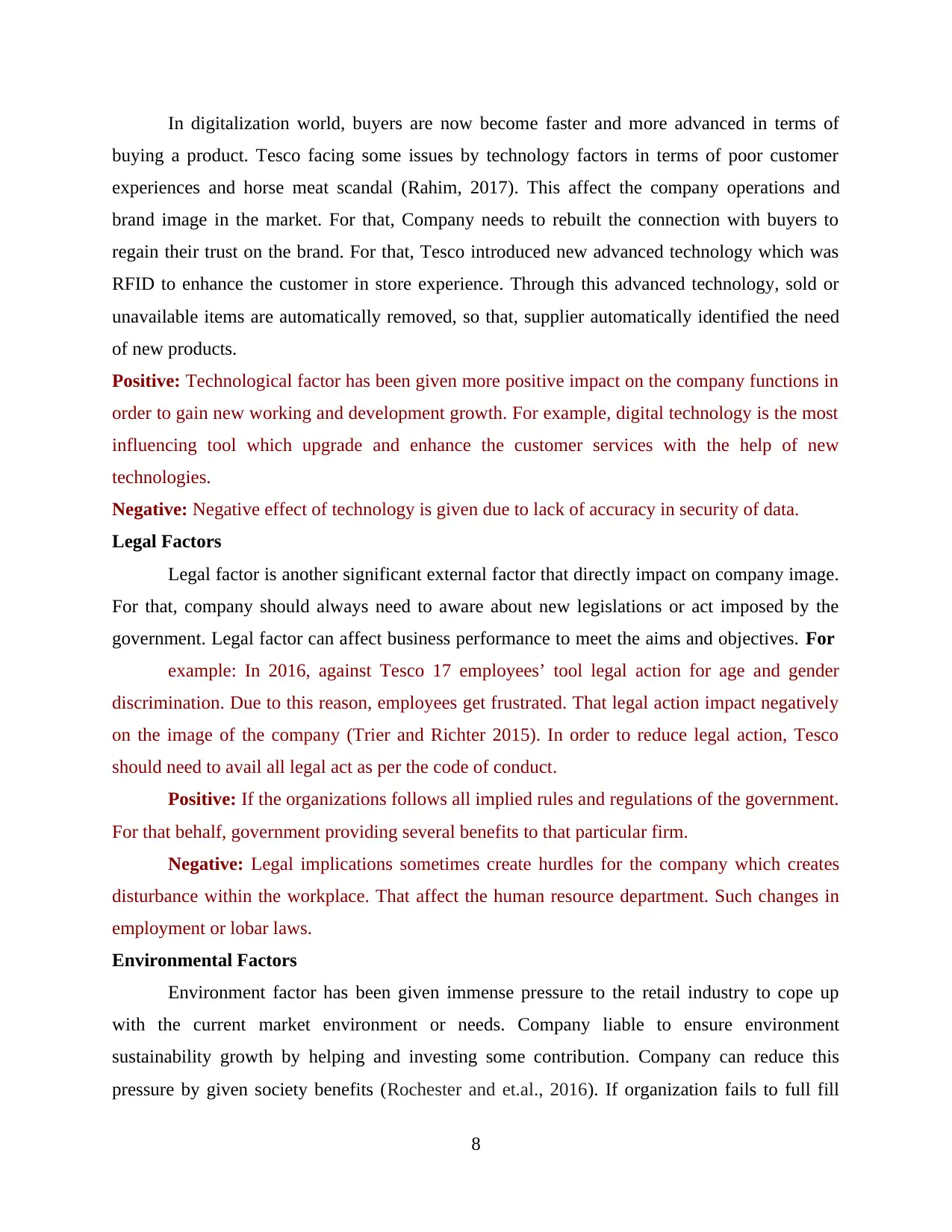
In digitalization world, buyers are now become faster and more advanced in terms of
buying a product. Tesco facing some issues by technology factors in terms of poor customer
experiences and horse meat scandal (Rahim, 2017). This affect the company operations and
brand image in the market. For that, Company needs to rebuilt the connection with buyers to
regain their trust on the brand. For that, Tesco introduced new advanced technology which was
RFID to enhance the customer in store experience. Through this advanced technology, sold or
unavailable items are automatically removed, so that, supplier automatically identified the need
of new products.
Positive: Technological factor has been given more positive impact on the company functions in
order to gain new working and development growth. For example, digital technology is the most
influencing tool which upgrade and enhance the customer services with the help of new
technologies.
Negative: Negative effect of technology is given due to lack of accuracy in security of data.
Legal Factors
Legal factor is another significant external factor that directly impact on company image.
For that, company should always need to aware about new legislations or act imposed by the
government. Legal factor can affect business performance to meet the aims and objectives. For
example: In 2016, against Tesco 17 employees’ tool legal action for age and gender
discrimination. Due to this reason, employees get frustrated. That legal action impact negatively
on the image of the company (Trier and Richter 2015). In order to reduce legal action, Tesco
should need to avail all legal act as per the code of conduct.
Positive: If the organizations follows all implied rules and regulations of the government.
For that behalf, government providing several benefits to that particular firm.
Negative: Legal implications sometimes create hurdles for the company which creates
disturbance within the workplace. That affect the human resource department. Such changes in
employment or lobar laws.
Environmental Factors
Environment factor has been given immense pressure to the retail industry to cope up
with the current market environment or needs. Company liable to ensure environment
sustainability growth by helping and investing some contribution. Company can reduce this
pressure by given society benefits (Rochester and et.al., 2016). If organization fails to full fill
8
buying a product. Tesco facing some issues by technology factors in terms of poor customer
experiences and horse meat scandal (Rahim, 2017). This affect the company operations and
brand image in the market. For that, Company needs to rebuilt the connection with buyers to
regain their trust on the brand. For that, Tesco introduced new advanced technology which was
RFID to enhance the customer in store experience. Through this advanced technology, sold or
unavailable items are automatically removed, so that, supplier automatically identified the need
of new products.
Positive: Technological factor has been given more positive impact on the company functions in
order to gain new working and development growth. For example, digital technology is the most
influencing tool which upgrade and enhance the customer services with the help of new
technologies.
Negative: Negative effect of technology is given due to lack of accuracy in security of data.
Legal Factors
Legal factor is another significant external factor that directly impact on company image.
For that, company should always need to aware about new legislations or act imposed by the
government. Legal factor can affect business performance to meet the aims and objectives. For
example: In 2016, against Tesco 17 employees’ tool legal action for age and gender
discrimination. Due to this reason, employees get frustrated. That legal action impact negatively
on the image of the company (Trier and Richter 2015). In order to reduce legal action, Tesco
should need to avail all legal act as per the code of conduct.
Positive: If the organizations follows all implied rules and regulations of the government.
For that behalf, government providing several benefits to that particular firm.
Negative: Legal implications sometimes create hurdles for the company which creates
disturbance within the workplace. That affect the human resource department. Such changes in
employment or lobar laws.
Environmental Factors
Environment factor has been given immense pressure to the retail industry to cope up
with the current market environment or needs. Company liable to ensure environment
sustainability growth by helping and investing some contribution. Company can reduce this
pressure by given society benefits (Rochester and et.al., 2016). If organization fails to full fill
8
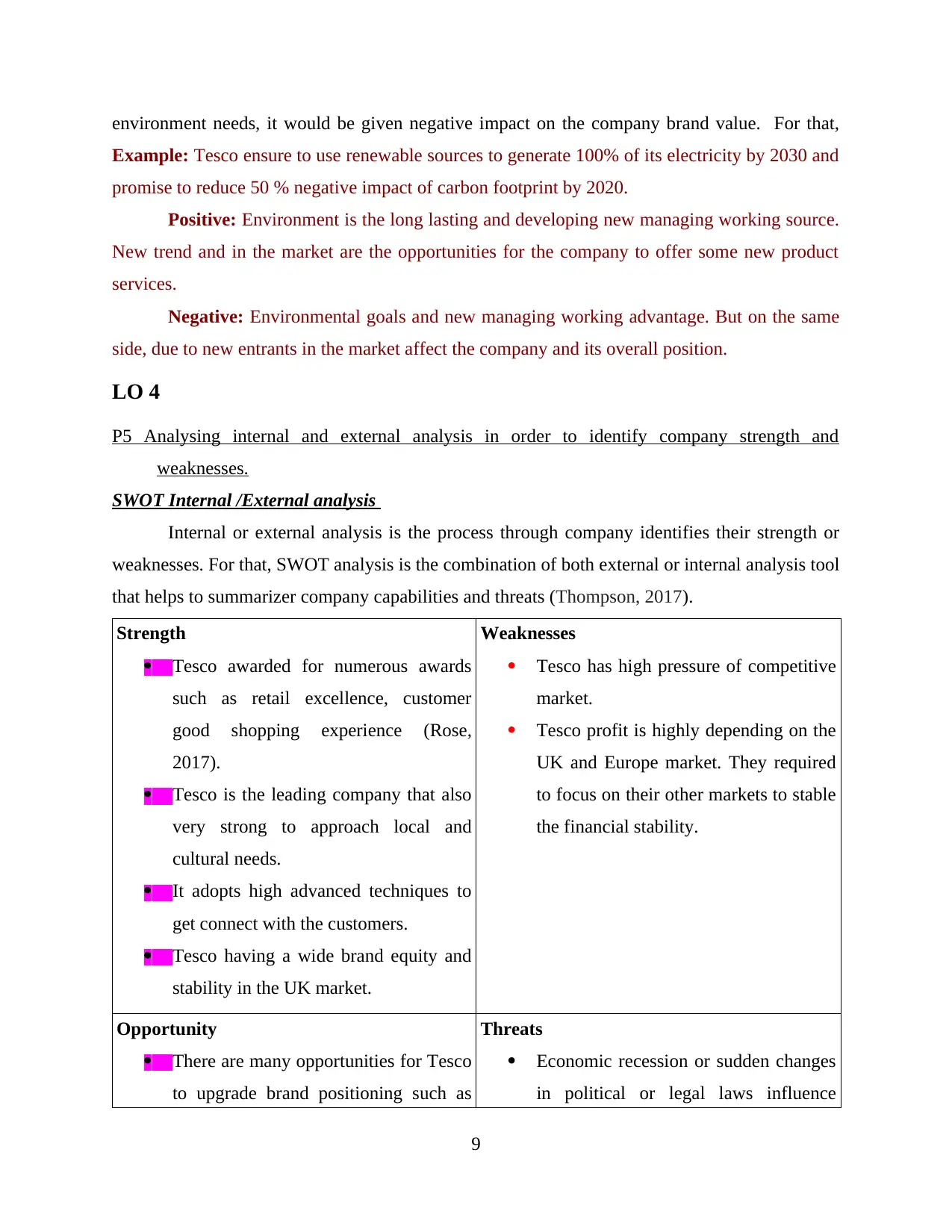
environment needs, it would be given negative impact on the company brand value. For that,
Example: Tesco ensure to use renewable sources to generate 100% of its electricity by 2030 and
promise to reduce 50 % negative impact of carbon footprint by 2020.
Positive: Environment is the long lasting and developing new managing working source.
New trend and in the market are the opportunities for the company to offer some new product
services.
Negative: Environmental goals and new managing working advantage. But on the same
side, due to new entrants in the market affect the company and its overall position.
LO 4
P5 Analysing internal and external analysis in order to identify company strength and
weaknesses.
SWOT Internal /External analysis
Internal or external analysis is the process through company identifies their strength or
weaknesses. For that, SWOT analysis is the combination of both external or internal analysis tool
that helps to summarizer company capabilities and threats (Thompson, 2017).
Strength
Tesco awarded for numerous awards
such as retail excellence, customer
good shopping experience (Rose,
2017).
Tesco is the leading company that also
very strong to approach local and
cultural needs.
It adopts high advanced techniques to
get connect with the customers.
Tesco having a wide brand equity and
stability in the UK market.
Weaknesses
Tesco has high pressure of competitive
market.
Tesco profit is highly depending on the
UK and Europe market. They required
to focus on their other markets to stable
the financial stability.
Opportunity
There are many opportunities for Tesco
to upgrade brand positioning such as
Threats
Economic recession or sudden changes
in political or legal laws influence
9
Example: Tesco ensure to use renewable sources to generate 100% of its electricity by 2030 and
promise to reduce 50 % negative impact of carbon footprint by 2020.
Positive: Environment is the long lasting and developing new managing working source.
New trend and in the market are the opportunities for the company to offer some new product
services.
Negative: Environmental goals and new managing working advantage. But on the same
side, due to new entrants in the market affect the company and its overall position.
LO 4
P5 Analysing internal and external analysis in order to identify company strength and
weaknesses.
SWOT Internal /External analysis
Internal or external analysis is the process through company identifies their strength or
weaknesses. For that, SWOT analysis is the combination of both external or internal analysis tool
that helps to summarizer company capabilities and threats (Thompson, 2017).
Strength
Tesco awarded for numerous awards
such as retail excellence, customer
good shopping experience (Rose,
2017).
Tesco is the leading company that also
very strong to approach local and
cultural needs.
It adopts high advanced techniques to
get connect with the customers.
Tesco having a wide brand equity and
stability in the UK market.
Weaknesses
Tesco has high pressure of competitive
market.
Tesco profit is highly depending on the
UK and Europe market. They required
to focus on their other markets to stable
the financial stability.
Opportunity
There are many opportunities for Tesco
to upgrade brand positioning such as
Threats
Economic recession or sudden changes
in political or legal laws influence
9
⊘ This is a preview!⊘
Do you want full access?
Subscribe today to unlock all pages.

Trusted by 1+ million students worldwide
1 out of 16
Related Documents
Your All-in-One AI-Powered Toolkit for Academic Success.
+13062052269
info@desklib.com
Available 24*7 on WhatsApp / Email
![[object Object]](/_next/static/media/star-bottom.7253800d.svg)
Unlock your academic potential
Copyright © 2020–2025 A2Z Services. All Rights Reserved. Developed and managed by ZUCOL.





